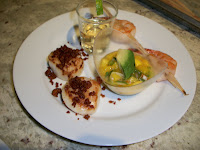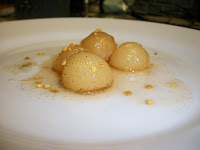For the past few months we have been working on perfecting our recycling and composting program, and we are about as close as you can get to zero waste. I currently serve about 1,200 meals a day, over 5,500 in a week. A year ago I looked into how much waste was going into the trash cans, from production and the dish room to what the guest was not eating off their plate. I figured we were throwing away around 600# of trash a day, straight into a landfill.
These figures didn’t make me very happy. We had been recycling pretty well, I thought, but I figured there had to be a better solution out there somewhere I choose to aggressively attack the problem of waste. It turned out we were throwing away a lot of items that could be recycled, but we didn’t know it because we didn’t realize what could actually be recycled. According to the local expert, nearly anything can be recycled, as long as it doesn’t have a pile of food on it. Used plastic wrap, aluminum foil, all paper, baggies and bun rack covers. By paying attention and retraining our staff, our recycling efforts have improved tremendously.
The real kicker to attacking waste has been composting. I tried composting with the production staff with two plastic bins out back behind the kitchen. I took away all the garbage cans and gave each station a half pan for their food scraps. The production staff now had to look at what it was throwing away, it was right in front of them. I could see it too, there was no hiding it and they couldn’t avoid it. Immediately they responded by not wasting what they could use, pass on to another station, or get creative with. Sometimes items need to be thrown out, sometimes an item will turn on you, it will hit the floor, or is just poor quality. This has given my staff a real practical lesson in what they were throwing away and has ended up actually making my staff better cooks. Now they are more self conscious about what they are not using and they have become more responsible with what they are using. It has become a contest to some to see what they can not throw away in a day of production. This has also stretched my dollar.
However, I learned a big lesson from the failure of my two plastic compost bins out back. While I was trying to compost, what I really had was a big pile of rotting food.
We did not compost any proteins or bones. These would lead to a few small four legged critters, and in Colorado, a few small four legged critters leads to many bigger four legged critters. This pile of rotting vegetables needed more time to decompose than I could give it, each day we were adding another ten pounds of kitchen scraps. I would need to stop composting in order to get it to break down and decompose. That didn’t sit right with me. I needed to find a solution, I wasn’t ready to give in, this can be done.
I spoke to Jesse, our Operations Director and explained to him what I was trying to do, the trouble I was running into, and showed him my rotting pile of muck. Through a connection of another staff member we teamed up with a guy named John-Paul. Now John-Paul is somewhat of a mad scientist, in a good way. John-Paul explains things to me that I have to tilt my head, squint one eye, and close the other to even begin to grasp. His vision is out there, realistic, and he is making things happen. Basically, I believe that John-Paul is the guy you will one day see on the cover of Time magazine one day. So you heard that here first. He isn’t going to be on the map, he is the map.
John-Paul told me that my composting wasn’t working because it was like a recipe, and I had the wrong ratio of ingredients. I had too much nitrogen and not enough carbon. That is, I had too much green (produce) and not enough brown (dead leaves and woody biomass materials) to make the breakdown more efficient. OK, now what? John-Paul explained to me what he could do with us and we have partnered up, his company is called Waste Farmers and here is how it works, my version.
In our kitchen and our dish room we have blue recycle bins next to green composting bins. Not only are we doing this with production, but with what are clients are not eating as well. We have gone down to about 250# of food waste a day for about 1,200 people. We did this by showing our clients what we are doing, and the clients have responded by not taking what they are not going to eat, and therefore wasting less. We have Waste Farmers large covered plastic bins out back on the dock, they come by once a week and leave us with empty ones.
A neat and tidy arrangement.
Waste Farmers composts all the usual suspects; paper napkins, grass, leaves, coffee grounds, you name it. But Waste Farmers is composting on such a large scale that it really makes sense for a large production kitchen. They will accept, dairy products, meat, poultry and seafood, rice, beans and pasta, and even bones and fat trimmings. See how he does it at http://www.wastefarmers.com/.
We have gone from adding 600# of waste into a landfill to less than 10# a week in under a year’s time. It seems that the hairnets some of my staff elects to wear are neither recyleable or compostable, and are the only items going into an actual trash can each day.
In short, the hats are ordered, soon trash will be no more.
Top 10 Things I Have Learned from Running
13 years ago















